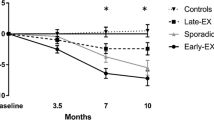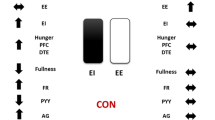Abstract
Aim: We assessed the effect of graded increases in exercised-induced energy expenditure (EE) on appetite, daily energy intake (EI), total daily EE and body weight in six lean women using a within-subject, repeated measures design.
Method: Subjects were each studied three times during 7 day treatments, corresponding to no-exercise (control; Nex; 0 MJ/day), medium exercise level (Mex; ∼1.9 MJ/day) and high exercise level (Hex; ∼3.4 MJ/day), with 2 day maintenance beforehand. Subjects self-weighed ad libitum food intake. EE was assessed by continual heart rate monitoring. During waking hours subjects recorded hourly sensations of hunger and appetite.
Results: EE amounted to 9.2, 11.0 and 12.1 MJ/day (F (2, 10)=5.67; P=0.023 (s.e.d.=0.87)) on the Nex, Mex and Hex treatments, respectively. The corresponding values for EI were 8.9, 9.2 and 10.0 MJ/day (F (2, 10)=4.80; P=0.035 (s.e.d.=0.36)). There were very weak treatment effects on hunger. Weight loss was significantly different from zero on the Mex and Hex treatments.
Conclusion: Markedly increasing EE through exercise produced significant but partial compensations in EI (∼33% of EE due to exercise). Accurate adjustments of El to acute increases in EE are likely to take weeks rather than days.
This is a preview of subscription content, access via your institution
Access options
Subscribe to this journal
Receive 12 print issues and online access
$259.00 per year
only $21.58 per issue
Buy this article
- Purchase on Springer Link
- Instant access to full article PDF
Prices may be subject to local taxes which are calculated during checkout
Similar content being viewed by others
References
Department of Health. Obesity. Reversing the increasing problem of obesity in England Report from the Nutrition and Physical Activity Task Forces Department of Health: London 1995.
King NA, Tremblay A, Blundell JE . Effects of exercise on appetite control: implications for energy balance Med Sci Sports Exerc 1997 29: 1076–1089.
Woo R, Garrow J, Pi-Sunyer F . Effect of exercise on spontaneous calorie intake in obesity Am J Clin Nutr 1982 36: 470–477.
Woo R, Pi-Sunyer F . Effect of increased physical activity on voluntary intake in lean women Metabolism 1985 34: 836–841.
Woo R, Garrow J . Voluntary food intake during prolonged exercise in obese woman Am J Clin Nutr 1982 36: 478–484.
King NA, Snell L, Smith RD, Blundell JE . Effects of short-term exercise on appetite responses in unrestrained females Eur J Clin Nutr 1996 50: 663–667.
King NA, Lluch A, Stubbs RJ, Blundell JE . High dose exercise does not increase hunger or energy intake in free living males Eur J Clin Nutr 1997 51: 478–483.
Dionne I, Johnson M, White MD, St-Pierre S, Tremblay A . Acute effect of exercise and low-fat diet on energy balance in heavy men Int J Obes Relat Metab Disord 1997 21: 413–416.
Tremblay A, Almeras N, Boer J, Kranenbarg EK, Despres JP . Diet composition and postexercise energy balance Am J Clin Nutr 1994 59: 975–979.
Johnstone AM, Stubbs RJ, Harbron CG . Effect of overfeeding macronutrients on day-to-day food intake in man Eur J Clin Nutr 1996 50: 418–430.
Van strein TV, Frijters JER, Bergers GPA, Defares PB . The Dutch Eating Behaviour Questionnaire (DEBQ) for assessment of restraint, emotional and external eating behaviour Int J Eat Disord 1986 5: 295–315.
Bingham SA, Cummings JH, Murgatroyd PR . PETRA: a new device for weighed dietary intakes 13th International Congress on Nutrition 1985 (Abstract) 126.
Ceesay SM, Prentice AM, Day KC, Murgatroyd PR, Goldberg GR, Scott W, Spurr GB . The use of heart rate monitoring in the estimation of energy expenditure: a validation study using indirect whole-body calorimetry Br J Nutr 1989 61: 175–186.
Holand B, Welch AA, Unwin ID, Buss DH, Paul AA DAT Southgate (eds). McCance & Widdowson's The composition of foods 5th edn HMSO: London 1991.
Stratton RJ, Stubbs RJ, Hughes D, King N, Blundell JE, Elia M . Comparison of the traditional paper visual analogue scale questionnaire with an Apple Newton electronic appetite rating system (EARS) in free living subjects feeding ad libitum Eur J Clin Nutr 1998 52: 737–741.
Forbes GF, Brown MR, Welle SL, Lipindski BA . Deliberate overfeeding in women and men: energy cost and composition of the weight gain Br J Nutr 1986 56: 1–9.
Author information
Authors and Affiliations
Corresponding author
Additional information
Part of this work was presented as an abstract at the Nutrition Society Summer Symposium, University of Surrey, Guildford, June 1998.
Rights and permissions
About this article
Cite this article
Stubbs, R., Sepp, A., Hughes, D. et al. The effect of graded levels of exercise on energy intake and balance in free-living women. Int J Obes 26, 866–869 (2002). https://doi.org/10.1038/sj.ijo.0801874
Received:
Revised:
Accepted:
Published:
Issue Date:
DOI: https://doi.org/10.1038/sj.ijo.0801874
Keywords
This article is cited by
-
Activity energy expenditure is an independent predictor of energy intake in humans
International Journal of Obesity (2019)
-
Biological and psychological mediators of the relationships between fat mass, fat-free mass and energy intake
International Journal of Obesity (2019)
-
The Unexplored Crossroads of the Female Athlete Triad and Iron Deficiency: A Narrative Review
Sports Medicine (2017)
-
Sex differences in the response of total PYY and GLP-1 to moderate-intensity continuous and sprint interval cycling exercise
European Journal of Applied Physiology (2017)
-
Modelling the associations between fat-free mass, resting metabolic rate and energy intake in the context of total energy balance
International Journal of Obesity (2016)



